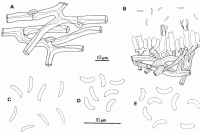|
 Postia atrostrigosa Postia atrostrigosa
SynonymsTyromyces atrostrigosus
Polyporus atrostrigosus
BiostatusPresent in region - Indigenous. Endemic
Images (click to enlarge)
Caption: Fig. 4 Postia venata (MR 10066), Polyporus setiger (PDD 39360), and Postia atrostrigosa
(PDD 6012). Microscopic characters of the fruit bodies. A-C, P. venata: A, generative hyphae; B,
hymenium; C, spores. D, P. s |
Article: Cunningham, G.H. (1965). Polyporaceae of New Zealand. New Zealand Department of Scientific and Industrial Research, Bulletin 164: 304 p. Wellington:.
Description: Hymenophore annual, solitary, hard and woody, laterally attached by a broad base, sometimes dimidiate and imbricate. Pilei triquetous or flabelliform, 2-4 cm wide, 1.5-2.5 cm radius, 5-8 mm thick; pileus surface dingy grey or black, densely clothed with coarse imbricated strigose tufts of hyphae radiately arranged, with walls fuscous and bearing granules of mucilage, obscurely sulcate; without a cortex; margin bluntly acuminate, lacerate, inturned; hymenial surface wood colour or smoky brown, irregular. Pores irregular, wood colour in section, angular, 4-6 per mm, 100-200 µm. diameter, to 5 mm deep; dissepiments 50-150 µm thick, tapering, apices strongly toothed. Context white or cream, 2-5 mm thick, firm and woody, of parallel hyphae radiately arranged and aggregated at intervals into compact bands; generative hyphae 5-7 µm diameter, 3-4 µm in dissepiments, walls 0.5-1.5 µm thick, sparsely branched, septate, with clamp connections. Hymenial layer to 18 µm deep, a dense palisade of basidia and paraphyses. Basidia subclavate, 10-12 x 3.5-4 µm, bearing 2-4 spores; sterigmata erect, slender, to 3 µm long. Paraphyses subclavate or subcylindrical, 6-10 x 3-3.5 µm. Spores allantoid, 4-5.5 x 1.5-2 µm, walls smooth, hyaline, 0.1 µm thick.
Habitat: Solitary or occasionally imbricate on bark or decorticated dead branches and trunks, associated with a brown cubical rot.
Distribution: New Zealand, Tasmania.
Notes: Specific features are the coarsely imbricated strigose black hairs clothing the pileus surface, small pores, and allantoid spores. The species is close to T. setiger, differing mainly in the smaller pores and different type of surface hairs. Lloyd (1922b, µm. 1147) recorded the species from Tasmania, but as he described spores as being elliptical, 6 x 5 µm, it is probable he had at hand a specimen of T. pelliculosus, which it resembles in surface features.
Article: Cooke, M.C. (1890). New Zealand fungi. Grevillea 19(89): 1-4.
Notes: With somewhat the appearance of a Polystictus, but anodermeous. Pileus 1-2 inches or
more diam., half an inch thick behind.
Article: Cunningham, G.H. (1948). New Zealand Polyporaceae. 3. The genus Polyporus. New Zealand Department of Scientific and Industrial Research, Plant Diseases Division, Bulletin 74: 39 p.
Description: Hymenophore annual, solitary, laterally attached by a broad base, hard and woody,
sometimes dimidiate and imbricate. Pileus triquetous or fan-shaped, to 4 cm. x 1.5-2.5 cm. x
5-8 mm.; surface black, densely coated with coarse imbricate strigose tufts of hyphae
radiately arranged, vaguely sulcate, cuticle wanting, replaced by imbricate hyphae with
rounded ends and fuscous walls; margin bluntly acuminate, lacerate, inturned; hymenial
surface wood colour to smoky brown, irregular, dissepiments strongly toothed. Context white
or cream, 2-5 mm. thick, of parallel hyphae radiately arranged, firm and woody; generative
hyphae 5-7 µ thick, wall 1 µ, sparsely branched, septate, clamp connections abundant and
large. Pores irregular, angular, to 5 mm. deep, wood colour in section, waxy, 100-200 µ
diameter, or 4-6 per mm.; dissepiments 50-150 µ thick, of parallel hyphae cemented together,
tapering to the apex where even. Basidial type clavate, basidia clavate, 10-12 x 3-4.5 µ.
Spores allantoid, 5-5.5 x 1.5-2 µ, smooth, hyaline.
Habitat: Growing solitary, sometimes imbricate, on decorticated rotting logs lying on the
forest floor.
Distribution: New Zealand.
Notes: Characterized by the coarse, imbricate, strigose black hairs which clothe the surface of the
pileus. The pigmented walls of these separate the species from P. setiger, which otherwise it
resembles.
Lloyd (1922, p. 1147) recorded the species from Tasmania. He described the spores as being
elliptical, 6 x 5 µ, so had obviously confused the species with some other, probably P. pelles
Lloyd, which has the pileus covered with dark coloured erect fibrils.
Article: Rajchenberg, M. (1995). Notes on New Zealand polypores (Basidiomycetes) 2. Cultural and morphological studies of selected species. New Zealand Journal of Botany 33(1): 99-109 (http://www.rsnz.org/publish/abstracts.php).
Description: Postia atrostrigosa (Cke) comb. nov. Basionym: Polyporus atrostrigosus Cke,
Grevillea 19: 2. 1890.
Postia atrostrigosa is part of a complex of species surrounding Postia caesia
(Schrad.: Fr.) Karst., given the blue colouration of the fruit bodies upon bruising or
drying and the amyloid, allantoid basidiospores.
|